Business Model Report: Examining Google's Innovative Strategies
VerifiedAdded on 2020/02/24
|8
|1758
|126
Report
AI Summary
This report delves into the concept of business models, defining them as conceptual structures that enable organizations to achieve their goals by creating and distributing value profitably. It explores the evolution of business models in the context of the internet revolution, highlighting the significance of e-commerce and its impact on traditional business approaches. The report emphasizes the importance of identifying market positions, forming competitive strategies, and understanding revenue models. It further examines the role of archetypes and the influence of technology on business model innovation, with a particular focus on Google's successful, multi-faceted business model. The analysis covers Google's value propositions, data-driven strategies, and its adaptation to the digital landscape. The report concludes by underscoring the ongoing transformation of business models due to technological advancements, offering insights into the future of business innovation.

Running head: BUSINESS MODEL
Business Model
Student Name
University name
Author Name
Business Model
Student Name
University name
Author Name
Paraphrase This Document
Need a fresh take? Get an instant paraphrase of this document with our AI Paraphraser
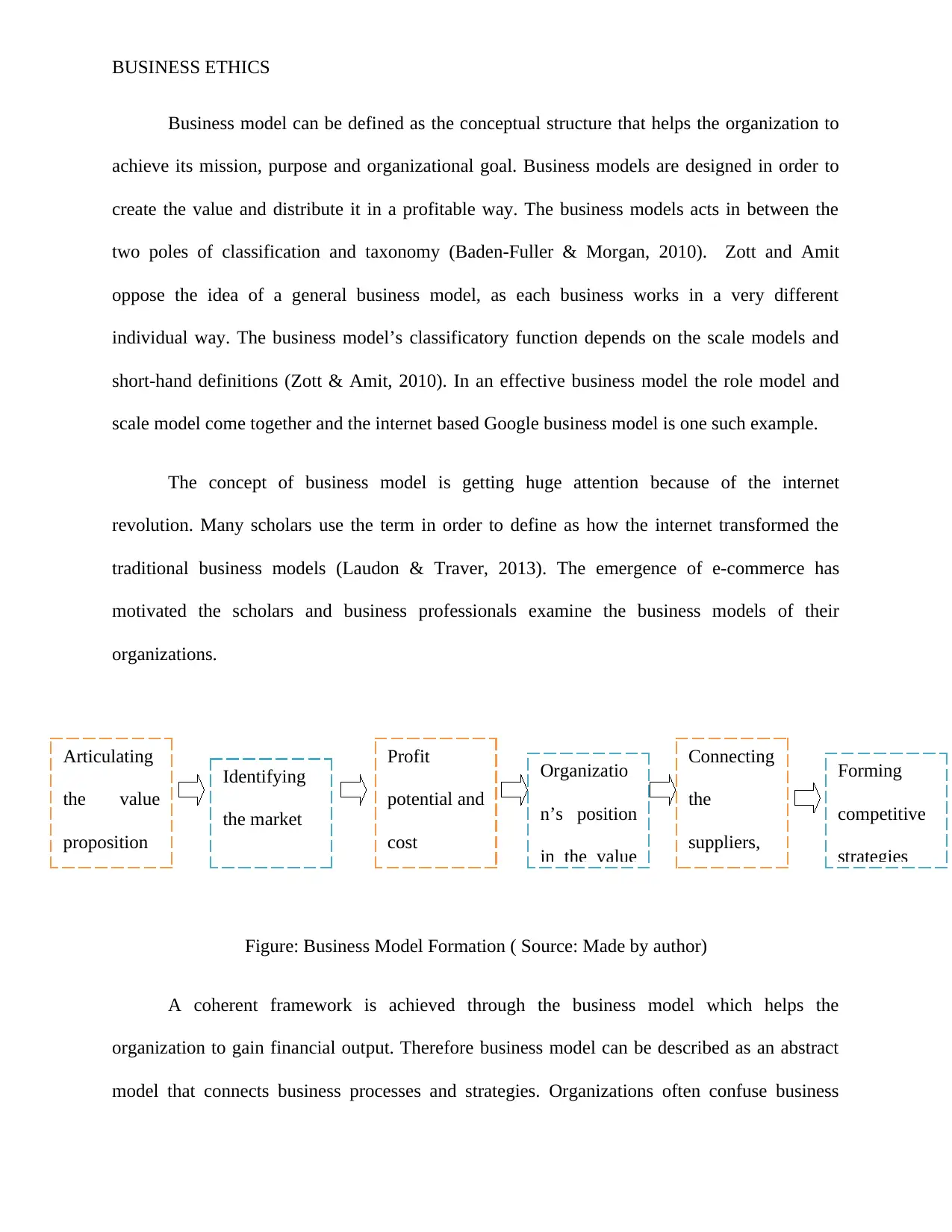
BUSINESS ETHICS
Business model can be defined as the conceptual structure that helps the organization to
achieve its mission, purpose and organizational goal. Business models are designed in order to
create the value and distribute it in a profitable way. The business models acts in between the
two poles of classification and taxonomy (Baden-Fuller & Morgan, 2010). Zott and Amit
oppose the idea of a general business model, as each business works in a very different
individual way. The business model’s classificatory function depends on the scale models and
short-hand definitions (Zott & Amit, 2010). In an effective business model the role model and
scale model come together and the internet based Google business model is one such example.
The concept of business model is getting huge attention because of the internet
revolution. Many scholars use the term in order to define as how the internet transformed the
traditional business models (Laudon & Traver, 2013). The emergence of e-commerce has
motivated the scholars and business professionals examine the business models of their
organizations.
Figure: Business Model Formation ( Source: Made by author)
A coherent framework is achieved through the business model which helps the
organization to gain financial output. Therefore business model can be described as an abstract
model that connects business processes and strategies. Organizations often confuse business
Articulating
the value
proposition
Identifying
the market
Profit
potential and
cost
structure
Organizatio
n’s position
in the value
Connecting
the
suppliers,
customers
Forming
competitive
strategies
Business model can be defined as the conceptual structure that helps the organization to
achieve its mission, purpose and organizational goal. Business models are designed in order to
create the value and distribute it in a profitable way. The business models acts in between the
two poles of classification and taxonomy (Baden-Fuller & Morgan, 2010). Zott and Amit
oppose the idea of a general business model, as each business works in a very different
individual way. The business model’s classificatory function depends on the scale models and
short-hand definitions (Zott & Amit, 2010). In an effective business model the role model and
scale model come together and the internet based Google business model is one such example.
The concept of business model is getting huge attention because of the internet
revolution. Many scholars use the term in order to define as how the internet transformed the
traditional business models (Laudon & Traver, 2013). The emergence of e-commerce has
motivated the scholars and business professionals examine the business models of their
organizations.
Figure: Business Model Formation ( Source: Made by author)
A coherent framework is achieved through the business model which helps the
organization to gain financial output. Therefore business model can be described as an abstract
model that connects business processes and strategies. Organizations often confuse business
Articulating
the value
proposition
Identifying
the market
Profit
potential and
cost
structure
Organizatio
n’s position
in the value
Connecting
the
suppliers,
customers
Forming
competitive
strategies
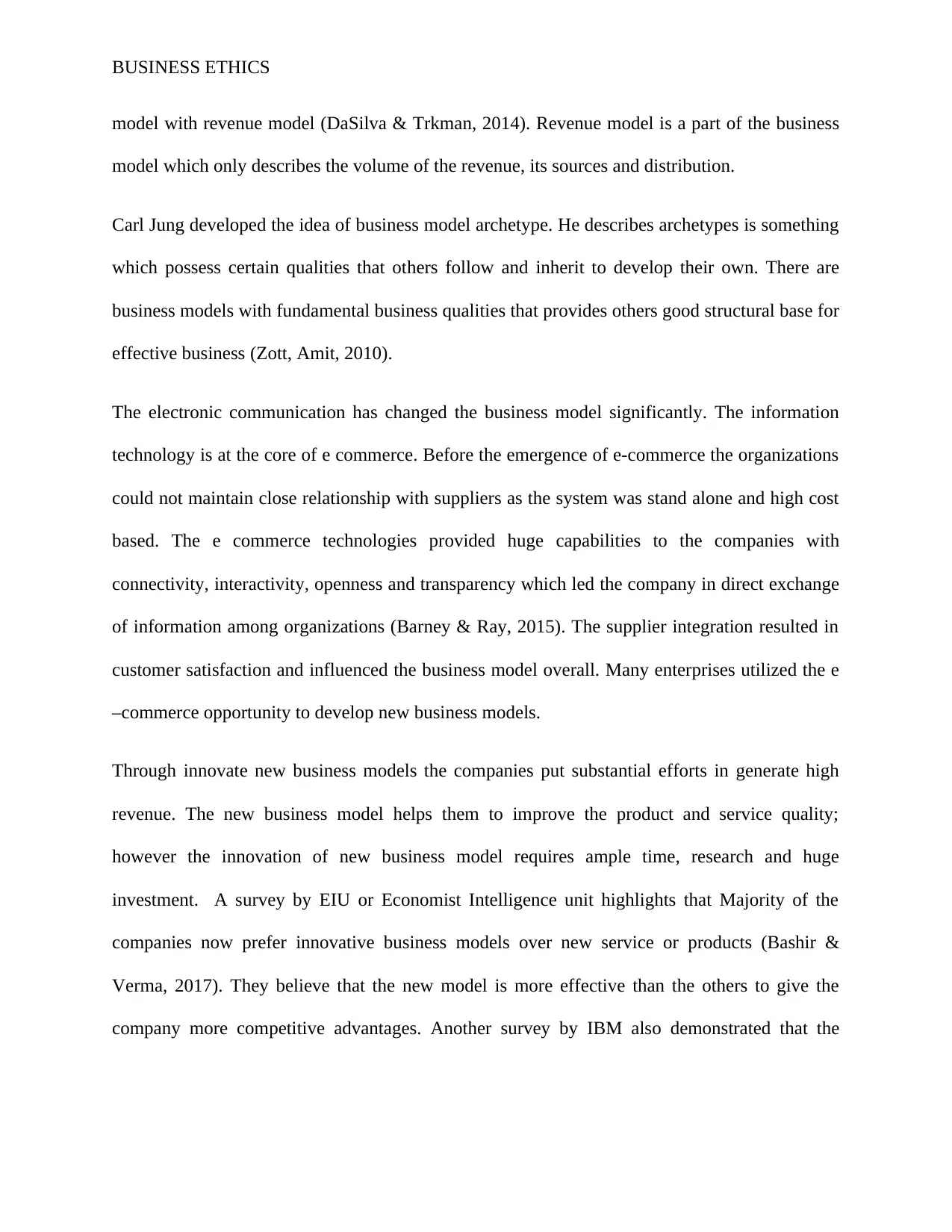
BUSINESS ETHICS
model with revenue model (DaSilva & Trkman, 2014). Revenue model is a part of the business
model which only describes the volume of the revenue, its sources and distribution.
Carl Jung developed the idea of business model archetype. He describes archetypes is something
which possess certain qualities that others follow and inherit to develop their own. There are
business models with fundamental business qualities that provides others good structural base for
effective business (Zott, Amit, 2010).
The electronic communication has changed the business model significantly. The information
technology is at the core of e commerce. Before the emergence of e-commerce the organizations
could not maintain close relationship with suppliers as the system was stand alone and high cost
based. The e commerce technologies provided huge capabilities to the companies with
connectivity, interactivity, openness and transparency which led the company in direct exchange
of information among organizations (Barney & Ray, 2015). The supplier integration resulted in
customer satisfaction and influenced the business model overall. Many enterprises utilized the e
–commerce opportunity to develop new business models.
Through innovate new business models the companies put substantial efforts in generate high
revenue. The new business model helps them to improve the product and service quality;
however the innovation of new business model requires ample time, research and huge
investment. A survey by EIU or Economist Intelligence unit highlights that Majority of the
companies now prefer innovative business models over new service or products (Bashir &
Verma, 2017). They believe that the new model is more effective than the others to give the
company more competitive advantages. Another survey by IBM also demonstrated that the
model with revenue model (DaSilva & Trkman, 2014). Revenue model is a part of the business
model which only describes the volume of the revenue, its sources and distribution.
Carl Jung developed the idea of business model archetype. He describes archetypes is something
which possess certain qualities that others follow and inherit to develop their own. There are
business models with fundamental business qualities that provides others good structural base for
effective business (Zott, Amit, 2010).
The electronic communication has changed the business model significantly. The information
technology is at the core of e commerce. Before the emergence of e-commerce the organizations
could not maintain close relationship with suppliers as the system was stand alone and high cost
based. The e commerce technologies provided huge capabilities to the companies with
connectivity, interactivity, openness and transparency which led the company in direct exchange
of information among organizations (Barney & Ray, 2015). The supplier integration resulted in
customer satisfaction and influenced the business model overall. Many enterprises utilized the e
–commerce opportunity to develop new business models.
Through innovate new business models the companies put substantial efforts in generate high
revenue. The new business model helps them to improve the product and service quality;
however the innovation of new business model requires ample time, research and huge
investment. A survey by EIU or Economist Intelligence unit highlights that Majority of the
companies now prefer innovative business models over new service or products (Bashir &
Verma, 2017). They believe that the new model is more effective than the others to give the
company more competitive advantages. Another survey by IBM also demonstrated that the
⊘ This is a preview!⊘
Do you want full access?
Subscribe today to unlock all pages.

Trusted by 1+ million students worldwide
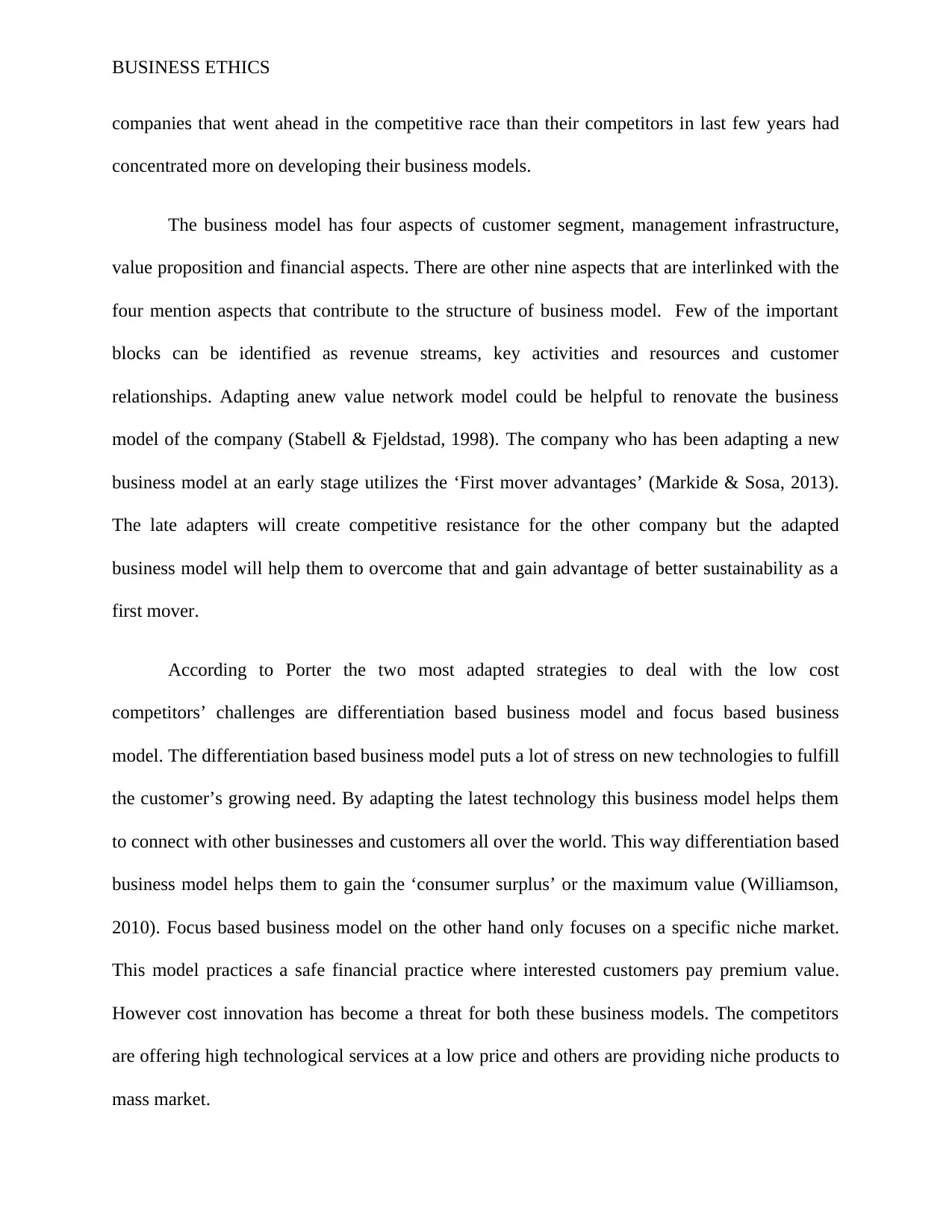
BUSINESS ETHICS
companies that went ahead in the competitive race than their competitors in last few years had
concentrated more on developing their business models.
The business model has four aspects of customer segment, management infrastructure,
value proposition and financial aspects. There are other nine aspects that are interlinked with the
four mention aspects that contribute to the structure of business model. Few of the important
blocks can be identified as revenue streams, key activities and resources and customer
relationships. Adapting anew value network model could be helpful to renovate the business
model of the company (Stabell & Fjeldstad, 1998). The company who has been adapting a new
business model at an early stage utilizes the ‘First mover advantages’ (Markide & Sosa, 2013).
The late adapters will create competitive resistance for the other company but the adapted
business model will help them to overcome that and gain advantage of better sustainability as a
first mover.
According to Porter the two most adapted strategies to deal with the low cost
competitors’ challenges are differentiation based business model and focus based business
model. The differentiation based business model puts a lot of stress on new technologies to fulfill
the customer’s growing need. By adapting the latest technology this business model helps them
to connect with other businesses and customers all over the world. This way differentiation based
business model helps them to gain the ‘consumer surplus’ or the maximum value (Williamson,
2010). Focus based business model on the other hand only focuses on a specific niche market.
This model practices a safe financial practice where interested customers pay premium value.
However cost innovation has become a threat for both these business models. The competitors
are offering high technological services at a low price and others are providing niche products to
mass market.
companies that went ahead in the competitive race than their competitors in last few years had
concentrated more on developing their business models.
The business model has four aspects of customer segment, management infrastructure,
value proposition and financial aspects. There are other nine aspects that are interlinked with the
four mention aspects that contribute to the structure of business model. Few of the important
blocks can be identified as revenue streams, key activities and resources and customer
relationships. Adapting anew value network model could be helpful to renovate the business
model of the company (Stabell & Fjeldstad, 1998). The company who has been adapting a new
business model at an early stage utilizes the ‘First mover advantages’ (Markide & Sosa, 2013).
The late adapters will create competitive resistance for the other company but the adapted
business model will help them to overcome that and gain advantage of better sustainability as a
first mover.
According to Porter the two most adapted strategies to deal with the low cost
competitors’ challenges are differentiation based business model and focus based business
model. The differentiation based business model puts a lot of stress on new technologies to fulfill
the customer’s growing need. By adapting the latest technology this business model helps them
to connect with other businesses and customers all over the world. This way differentiation based
business model helps them to gain the ‘consumer surplus’ or the maximum value (Williamson,
2010). Focus based business model on the other hand only focuses on a specific niche market.
This model practices a safe financial practice where interested customers pay premium value.
However cost innovation has become a threat for both these business models. The competitors
are offering high technological services at a low price and others are providing niche products to
mass market.
Paraphrase This Document
Need a fresh take? Get an instant paraphrase of this document with our AI Paraphraser
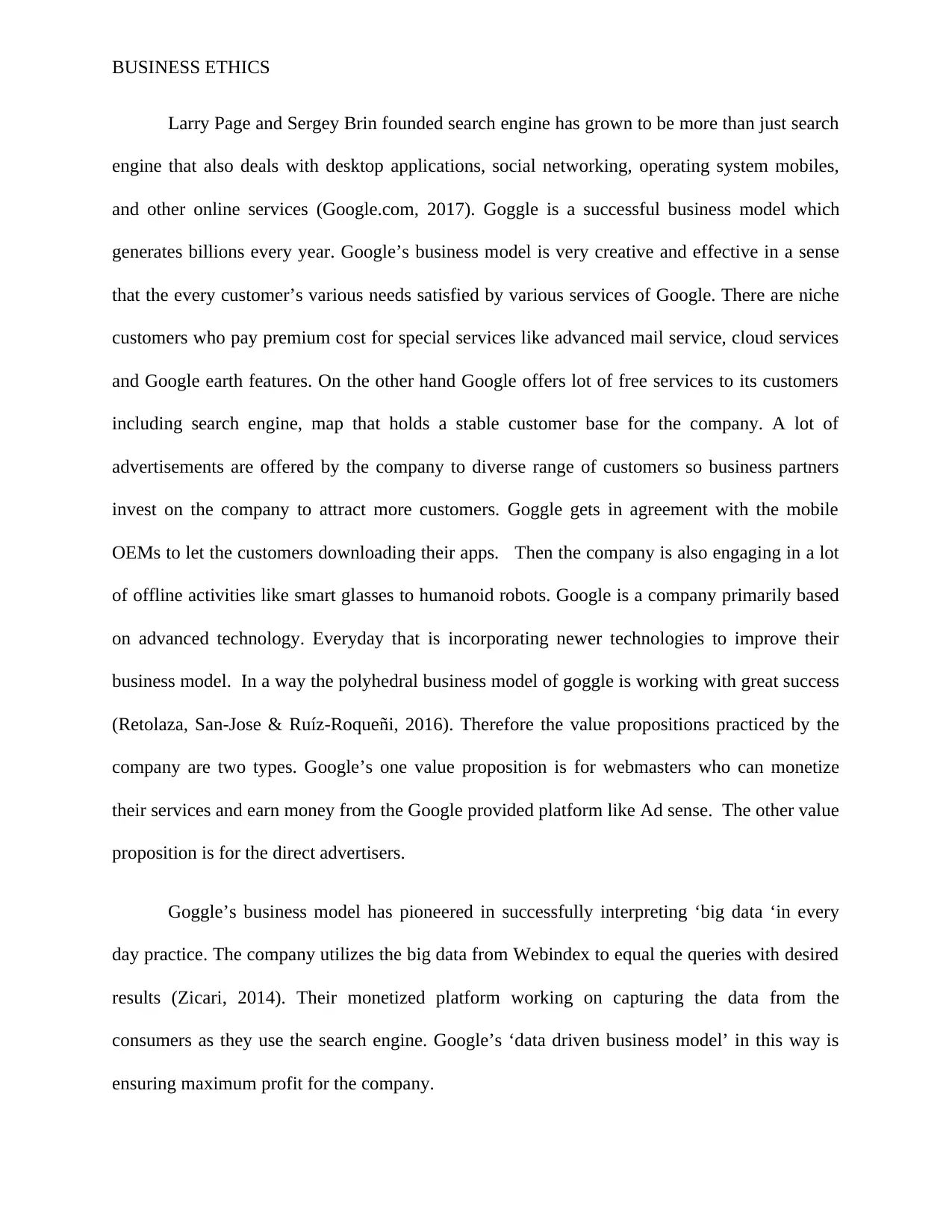
BUSINESS ETHICS
Larry Page and Sergey Brin founded search engine has grown to be more than just search
engine that also deals with desktop applications, social networking, operating system mobiles,
and other online services (Google.com, 2017). Goggle is a successful business model which
generates billions every year. Google’s business model is very creative and effective in a sense
that the every customer’s various needs satisfied by various services of Google. There are niche
customers who pay premium cost for special services like advanced mail service, cloud services
and Google earth features. On the other hand Google offers lot of free services to its customers
including search engine, map that holds a stable customer base for the company. A lot of
advertisements are offered by the company to diverse range of customers so business partners
invest on the company to attract more customers. Goggle gets in agreement with the mobile
OEMs to let the customers downloading their apps. Then the company is also engaging in a lot
of offline activities like smart glasses to humanoid robots. Google is a company primarily based
on advanced technology. Everyday that is incorporating newer technologies to improve their
business model. In a way the polyhedral business model of goggle is working with great success
(Retolaza, San-Jose & Ruíz-Roqueñi, 2016). Therefore the value propositions practiced by the
company are two types. Google’s one value proposition is for webmasters who can monetize
their services and earn money from the Google provided platform like Ad sense. The other value
proposition is for the direct advertisers.
Goggle’s business model has pioneered in successfully interpreting ‘big data ‘in every
day practice. The company utilizes the big data from Webindex to equal the queries with desired
results (Zicari, 2014). Their monetized platform working on capturing the data from the
consumers as they use the search engine. Google’s ‘data driven business model’ in this way is
ensuring maximum profit for the company.
Larry Page and Sergey Brin founded search engine has grown to be more than just search
engine that also deals with desktop applications, social networking, operating system mobiles,
and other online services (Google.com, 2017). Goggle is a successful business model which
generates billions every year. Google’s business model is very creative and effective in a sense
that the every customer’s various needs satisfied by various services of Google. There are niche
customers who pay premium cost for special services like advanced mail service, cloud services
and Google earth features. On the other hand Google offers lot of free services to its customers
including search engine, map that holds a stable customer base for the company. A lot of
advertisements are offered by the company to diverse range of customers so business partners
invest on the company to attract more customers. Goggle gets in agreement with the mobile
OEMs to let the customers downloading their apps. Then the company is also engaging in a lot
of offline activities like smart glasses to humanoid robots. Google is a company primarily based
on advanced technology. Everyday that is incorporating newer technologies to improve their
business model. In a way the polyhedral business model of goggle is working with great success
(Retolaza, San-Jose & Ruíz-Roqueñi, 2016). Therefore the value propositions practiced by the
company are two types. Google’s one value proposition is for webmasters who can monetize
their services and earn money from the Google provided platform like Ad sense. The other value
proposition is for the direct advertisers.
Goggle’s business model has pioneered in successfully interpreting ‘big data ‘in every
day practice. The company utilizes the big data from Webindex to equal the queries with desired
results (Zicari, 2014). Their monetized platform working on capturing the data from the
consumers as they use the search engine. Google’s ‘data driven business model’ in this way is
ensuring maximum profit for the company.
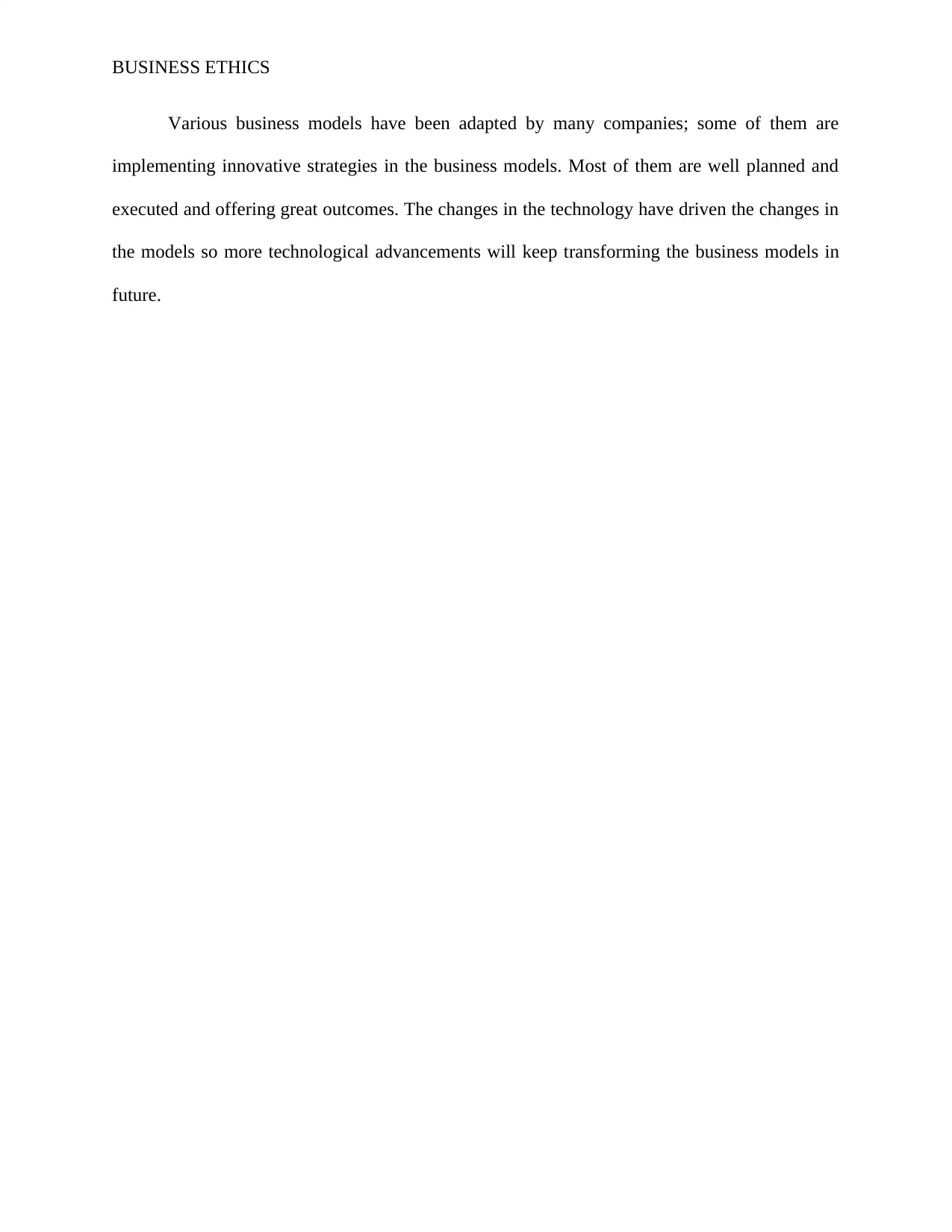
BUSINESS ETHICS
Various business models have been adapted by many companies; some of them are
implementing innovative strategies in the business models. Most of them are well planned and
executed and offering great outcomes. The changes in the technology have driven the changes in
the models so more technological advancements will keep transforming the business models in
future.
Various business models have been adapted by many companies; some of them are
implementing innovative strategies in the business models. Most of them are well planned and
executed and offering great outcomes. The changes in the technology have driven the changes in
the models so more technological advancements will keep transforming the business models in
future.
⊘ This is a preview!⊘
Do you want full access?
Subscribe today to unlock all pages.

Trusted by 1+ million students worldwide
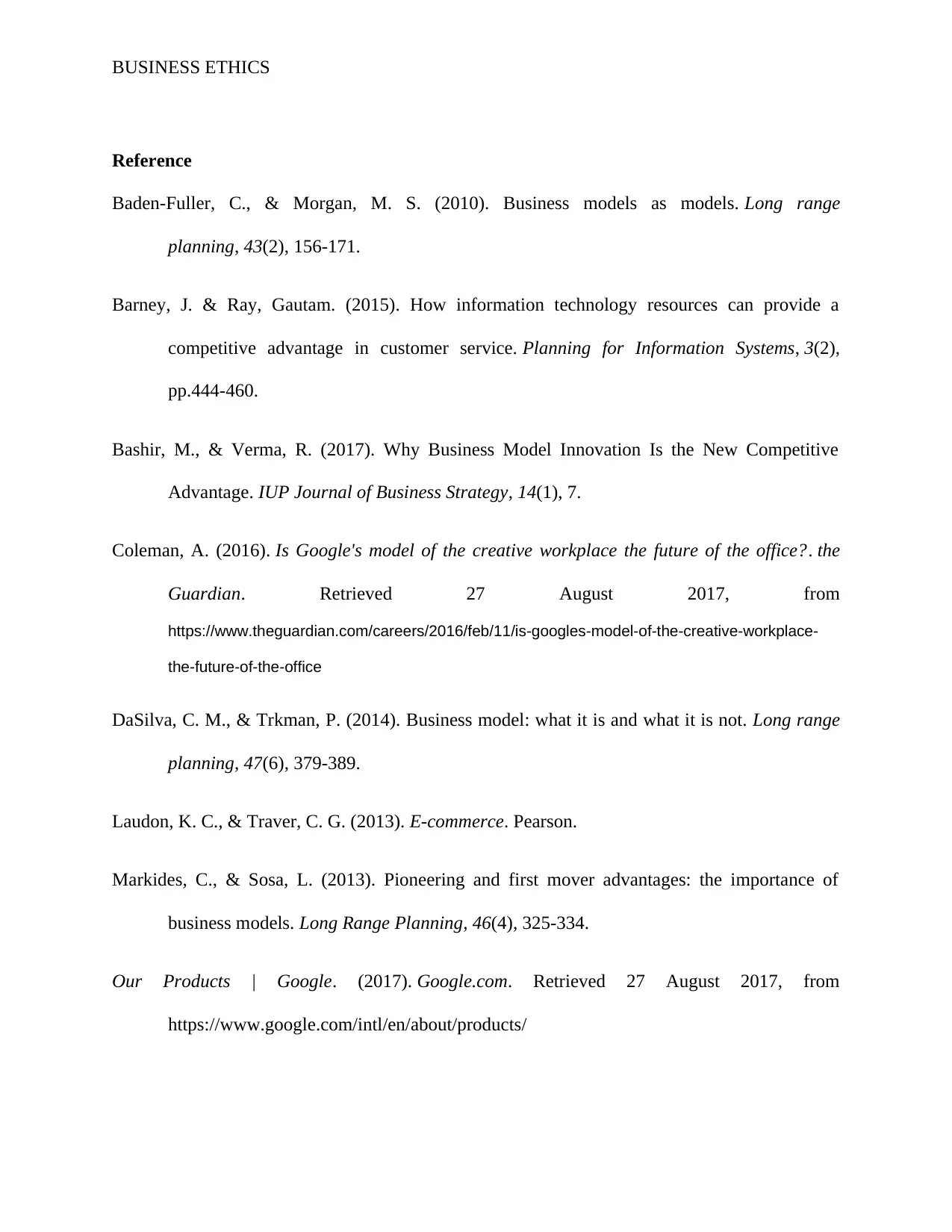
BUSINESS ETHICS
Reference
Baden-Fuller, C., & Morgan, M. S. (2010). Business models as models. Long range
planning, 43(2), 156-171.
Barney, J. & Ray, Gautam. (2015). How information technology resources can provide a
competitive advantage in customer service. Planning for Information Systems, 3(2),
pp.444-460.
Bashir, M., & Verma, R. (2017). Why Business Model Innovation Is the New Competitive
Advantage. IUP Journal of Business Strategy, 14(1), 7.
Coleman, A. (2016). Is Google's model of the creative workplace the future of the office?. the
Guardian. Retrieved 27 August 2017, from
https://www.theguardian.com/careers/2016/feb/11/is-googles-model-of-the-creative-workplace-
the-future-of-the-office
DaSilva, C. M., & Trkman, P. (2014). Business model: what it is and what it is not. Long range
planning, 47(6), 379-389.
Laudon, K. C., & Traver, C. G. (2013). E-commerce. Pearson.
Markides, C., & Sosa, L. (2013). Pioneering and first mover advantages: the importance of
business models. Long Range Planning, 46(4), 325-334.
Our Products | Google. (2017). Google.com. Retrieved 27 August 2017, from
https://www.google.com/intl/en/about/products/
Reference
Baden-Fuller, C., & Morgan, M. S. (2010). Business models as models. Long range
planning, 43(2), 156-171.
Barney, J. & Ray, Gautam. (2015). How information technology resources can provide a
competitive advantage in customer service. Planning for Information Systems, 3(2),
pp.444-460.
Bashir, M., & Verma, R. (2017). Why Business Model Innovation Is the New Competitive
Advantage. IUP Journal of Business Strategy, 14(1), 7.
Coleman, A. (2016). Is Google's model of the creative workplace the future of the office?. the
Guardian. Retrieved 27 August 2017, from
https://www.theguardian.com/careers/2016/feb/11/is-googles-model-of-the-creative-workplace-
the-future-of-the-office
DaSilva, C. M., & Trkman, P. (2014). Business model: what it is and what it is not. Long range
planning, 47(6), 379-389.
Laudon, K. C., & Traver, C. G. (2013). E-commerce. Pearson.
Markides, C., & Sosa, L. (2013). Pioneering and first mover advantages: the importance of
business models. Long Range Planning, 46(4), 325-334.
Our Products | Google. (2017). Google.com. Retrieved 27 August 2017, from
https://www.google.com/intl/en/about/products/
Paraphrase This Document
Need a fresh take? Get an instant paraphrase of this document with our AI Paraphraser
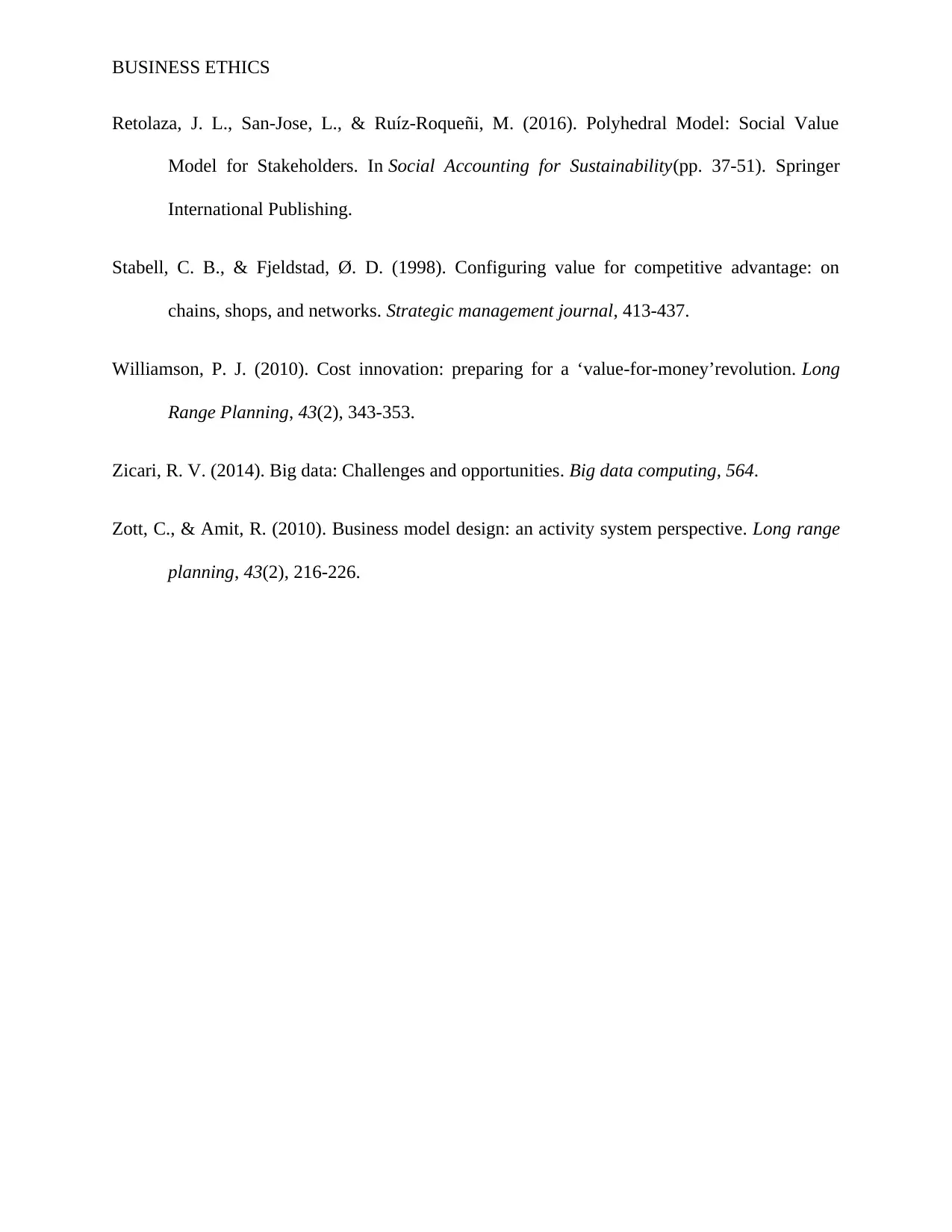
BUSINESS ETHICS
Retolaza, J. L., San-Jose, L., & Ruíz-Roqueñi, M. (2016). Polyhedral Model: Social Value
Model for Stakeholders. In Social Accounting for Sustainability(pp. 37-51). Springer
International Publishing.
Stabell, C. B., & Fjeldstad, Ø. D. (1998). Configuring value for competitive advantage: on
chains, shops, and networks. Strategic management journal, 413-437.
Williamson, P. J. (2010). Cost innovation: preparing for a ‘value-for-money’revolution. Long
Range Planning, 43(2), 343-353.
Zicari, R. V. (2014). Big data: Challenges and opportunities. Big data computing, 564.
Zott, C., & Amit, R. (2010). Business model design: an activity system perspective. Long range
planning, 43(2), 216-226.
Retolaza, J. L., San-Jose, L., & Ruíz-Roqueñi, M. (2016). Polyhedral Model: Social Value
Model for Stakeholders. In Social Accounting for Sustainability(pp. 37-51). Springer
International Publishing.
Stabell, C. B., & Fjeldstad, Ø. D. (1998). Configuring value for competitive advantage: on
chains, shops, and networks. Strategic management journal, 413-437.
Williamson, P. J. (2010). Cost innovation: preparing for a ‘value-for-money’revolution. Long
Range Planning, 43(2), 343-353.
Zicari, R. V. (2014). Big data: Challenges and opportunities. Big data computing, 564.
Zott, C., & Amit, R. (2010). Business model design: an activity system perspective. Long range
planning, 43(2), 216-226.
1 out of 8
Related Documents
Your All-in-One AI-Powered Toolkit for Academic Success.
+13062052269
info@desklib.com
Available 24*7 on WhatsApp / Email
![[object Object]](/_next/static/media/star-bottom.7253800d.svg)
Unlock your academic potential
Copyright © 2020–2025 A2Z Services. All Rights Reserved. Developed and managed by ZUCOL.





